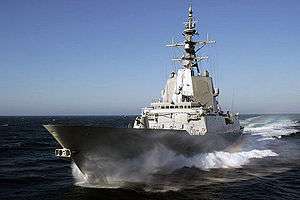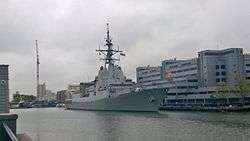Álvaro de Bazán-class frigate
The Álvaro de Bazán class, also known as the F100 class, is a class of Aegis combat system-equipped air defence frigates in service with the Spanish Navy. The vessels were built by Spanish shipbuilder Navantia in Ferrol, with the lead ship of the class named for Admiral Álvaro de Bazán.
 Almirante Juan de Borbón | |
| Class overview | |
|---|---|
| Name: | Álvaro de Bazán class |
| Builders: | NAVANTIA-IZAR, Astillero Ferrol |
| Operators: |
|
| Preceded by: | Santa María class |
| Succeeded by: | F110 class |
| Subclasses: | Hobart class |
| Cost: |
F101/4 €453m[1] (~US$600m) each F105 €834m[1] (~US$1.1bn) |
| Planned: | 6 |
| Cancelled: | 1 |
| Active: | 5 |
| General characteristics [2] | |
| Type: | Guided missile frigate |
| Displacement: | |
| Length: | 146.7 m (481 ft) |
| Beam: | 18.6 m (61 ft) |
| Draft: | 4.75 m (15.6 ft) |
| Installed power: |
|
| Propulsion: |
|
| Speed: | 28 kn (52 km/h; 32 mph) |
| Range: | 4,500 nmi (8,300 km; 5,200 mi) at 18 kn (33 km/h; 21 mph) |
| Complement: | 201 |
| Sensors and processing systems: | |
| Electronic warfare & decoys: | |
| Armament: |
|
| Aircraft carried: | 1 × Sikorsky SH-60B LAMPS III Seahawk |
The ships are fitted with American Aegis weapons system allowing them to track hundreds of airborne targets simultaneously as part of its air defence network. The Álvaro de Bazán-class multi-role frigates are one of the few non-US warships to carry the Aegis system and its associated SPY-1D radar. The American Arleigh Burke class, Japanese Kongo class, Korean Sejong the Great class, Australian Hobart class, and the Norwegian Fridtjof Nansen class also use the Aegis system.
The Álvaro de Bazán-class frigates are the first modern vessels of the Spanish Navy to incorporate ballistic resistant steel in the hull, along with the power plants being mounted on anti-vibration mounts to reduce noise and make them less detectable by submarines. The original contract for four ships was worth €1.683 billion but they ended up costing €1.81 billion.[1] As of 2010 it was estimated that the final vessel, F-105 would cost €834m[1] (~US$1.1bn).
Ships in class

Six ships were originally planned, including Roger de Lauria (F105) and Juan de Austria (F106). These were cancelled but a fifth ship was later added as the F105 Cristóbal Colón.
| Pennant number | Name | Laid down | Launched | Commissioned | Status | ||
|---|---|---|---|---|---|---|---|
| F101 | Álvaro de Bazán | October 2000 | September 2002 | Active | |||
| F102 | Almirante Juan de Borbón | October 2001 | 28 February 2002 | 3 December 2003 | Active | ||
| F103 | Blas de Lezo | 16 May 2003 | 16 December 2004 | Active | |||
| F104 | Méndez Núñez | 16 May 2003 | 12 November 2004 | 21 March 2006 | Active | ||
| F105 | Roger de Lauria renamed Cristóbal Colón |
29 June 2007 | 4 November 2010 | 23 October 2012 | Active | ||
| F106 | Juan de Austria | Cancelled | |||||
Export
The class is the basis of the Australian Hobart-class destroyers, previously known as the Air Warfare Destroyer. The Australian government announced in June 2007 that, in partnership with Navantia, three F100 vessels will be built for the Royal Australian Navy (RAN) with the first due for delivery in 2014, however this was delayed until 2017 when lead ship HMAS Hobart was commissioned.
References
- Ministerio de Defensa (September 2011). "Evaluación de los Programas Especiales de Armamento (PEAs)" (PDF) (in Spanish). Madrid: Grupo Atenea. Archived from the original (PDF) on 17 January 2012. Retrieved 30 September 2012.
- "Alvaro de Bazan (F100) class Guided Missile Frigate". www.seaforces.org. Retrieved 31 July 2020.
External links
| Wikimedia Commons has media related to Alvaro de Bazan Class. |
- Armada Española
- Spanish Navy page on Andrew Toppan's Haze Gray and Underway
- See Armada Española Photos
- Spanish Ship Joins TR Strike Group
- Spain: Frigate not involved in combat
- Navy unveils $11b warship contract, Australian Broadcasting Corporation, accessed 20 June 2007.